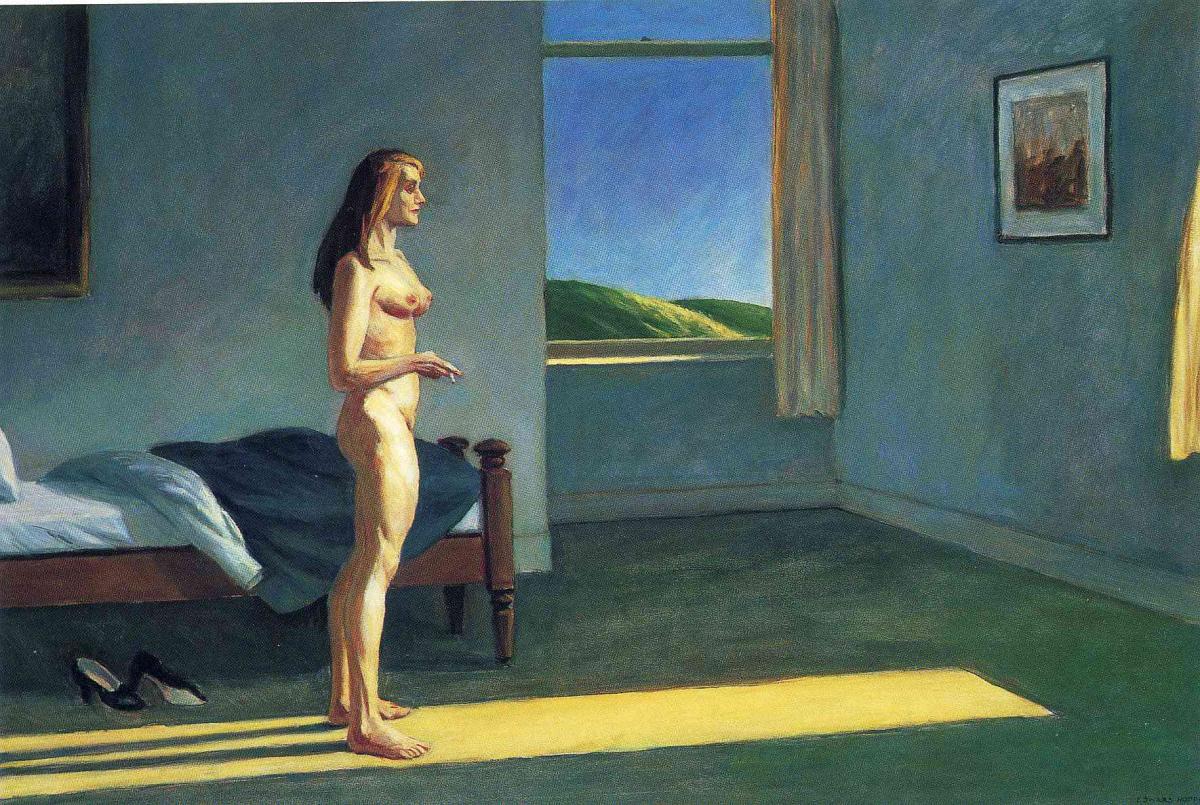Edward Hopper's Journey of Inspirations
Created by Aeryal Palazzi on Sat, 04/12/2025 - 13:53
This timeline provides a sociohistorical context for Edward Hopper 1961 A Women in the Sun.

Hopper, Edward. A Women in the Sun.1961. https://uploads1.wikiart.org/images/edward-hopper/woman-in-the-sun.jpg
Timeline
Chronological table
| Date | Event | Created by | Associated Places | |
|---|---|---|---|---|
| 1906 to 1910 |
Edgar Degas and Eduard ManetBetween the years 1906 - 1910 during his very first couple of trips to Paris, he came across artwork created by Edgar Degas and Eduard Manet. He got inspired by these two artists and started making paintings close to their work but in his style. Degas and Manet's paintings focused more on depicting modern-day life in rural and urban areas. Ment focused more on women who are challenging social norms and societal expectations. While Degas focused more on women in intimate domestic areas focusing on ordinary aspects in their lives. Manet gave more of a direct, bold gaze; he also used color to give more sense of warmth and closeness to the viewers. Degas worked with more pastels and paid more attention to details trying to give his artwork sensitivity and empathy but also having that sense of softness to it. His work was more on ballet.
Ostrow, Saul. “Manet and Degas as Realists.” Art Spiel, 12 May 2024, artspiel.org/manet-and-degas-as-realists/#:~:text=Manet’s%20women%20often%20appeared%20in,relatives%2C%20friends%2C%20and%20models.
“10 Things You May Not Know About Edward Hopper - Google Arts & Culture.” Google, Google, artsandculture.google.com/story/10-things-you-may-not-know-about-edward-hopper/CgWRr_TwNo1tLQ?hl=en. |
Aeryal Palazzi | ||
| 1923 to 1967 |
Josephine and Hoppers RelationshipMany artists have different muses for each artwork. Hopper's muse for his artworks is his wife Josephine who also goes by the name Jo. Before they got married Josephine was a successful artist herself. Most of her artwork involved watercolors using bold colors to paint landscapes and still life. Jo and Edward crossed many paths but never acknowledged each other enough until 1923 In Massachusetts at an art colony. She lost her cat and he helped her find it. After that, they started to acknowledge each other and soon got into a serious relationship. Jo encouraged Edward to move his artwork and with her connection to the art world she was able to help his art be recognized. His artwork became more successful. Eventually, after that, they got married. Years went by and as Hopper's success grew he started to resent Jo. She eventually stopped doing art due to always posing and helping Hopper out. She kept records of his work, sales, and all of his exhibits. There is a dark side to this relationship though. Hopper had damaged Jo's mental health and made sure that she was unhappy and he even tried to forbid Jo to paint. He knew if she was happy she would paint so he would make her unhappy. If she was unhappy he would use that as part of his muse for painting.
Kirpalov, Anastasiia. “Edward Hopper & Josephine Nivison: The Troubled Artistic Union.” TheCollector, www.thecollector.com/edward-hopper-josephine-nivison-artistic-union/#. |
Aeryal Palazzi | ||
| 1933 |
Hoppers ExhibitsEdward Hopper's most successful event that has ever happened to him was not his one-person exhibit but instead his second one-person exhibit. In 1924 this event was the most successful because every single one of his paintings was sold. Since all of the paintings were sold this also marked the beginning of his successful art journey and long-term connections with the gallery. That connection also helped him find a representative for his career. Around 1933 he got critical recognition for his urban mature style. Which were scenes of landscapes and interior work that had a sense of quiet, loss, anxiety, and their personal disconnection with the world. Today his most iconic and more recognizable artwork that is still popular is his piece That he created in 1942 called Nighthawks. After that one person exhibited and got that critical recognition he found his own successful style in the art world.
Murphy, Jessica. “Edward Hopper (1882–1967).” The Metropolitan Museum of Art, www.metmuseum.org/essays/edward-hopper-1882-1967. |
Aeryal Palazzi | ||
| 2025 |
Analyzed ArtThese three events are important and very helpful when interpreting the art piece. If Edward Hopper did not go to Paris and discovered work by Edgar Degas and Eduard Manet, he probably would not have been inspired to make the paintings that we see today. Hopper used their idea with modern life in rural and urban life using landscapes and different interiors of rooms. Seeing how each of these artists used lighting and shadow in their work he uses that to create a stillness type of contemplation in the work. The next event was his wife, Josephine. All the women that he has painted were of his wife. She posed for his artwork. She was the one who encouraged him to show his artwork in other areas and places. She even encouraged him to use more watercolors. She used her connection with the art world to help him and if he hadn’t met her he could have been in the same place and not been as successful as he is now because of her. He also used some of her emotions in his artwork like for instance her being unhappy and lost. He also used other people's emotions or seeing how distant they are in certain areas to help him as well. The last event was his second one-person exhibit. This was where his art pieces became more recognized because of his style. This was the increase in his success and popularity. He was becoming more known and he started to create more work which led to him making pieces like Nighthawks. |
Aeryal Palazzi |



